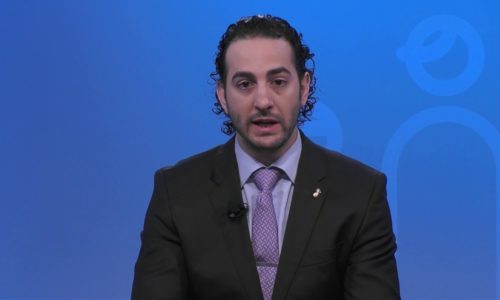Epigastric, umbilical, and lateral hernia are some types of hernias. Dr. Juan-Carlos Verdeja, General Surgeon with West Kendall Baptist Hospital, talks about each one and explains where they are located.
There are different types of hernias and I know you said a hole so can you walk us through these and where they occur exactly in the body in the abdomen all right so you’ll see this diagram of an abdomen okay and what you’ll see is the very top you see what’s called an epic gastric her knee and epigastric hernia is a hernia that occurs anywhere in the line from the little bone at the bottom of your chest to your belly button that’s what I have so anywhere along that way you can have defects why does that happen because when the when the abdomen is forming embryologically the intestines are actually outside the belly and as they progress and close they fall into the belly and then the muscle wall closes well the last part of the muscle wall that closes that part and sometimes it closes in completely so you have little defects which over time crying as a baby lifting things as an adult pregnancies etc will slowly separate and it create these defects so that happens the muscle wall isn’t completely closed correct so you have a small native defect and oftentimes you’re not aware of it and oftentimes there’s several of them and only the most prominent one shows and these umbilical and epigastric granules you said are very common in women that is true because of pregnancies you see them more commonly in women because as the abdomen stretches you see that they tend to stretch those areas umbilical hernia occurs because at birth were all we’re all born with our belly button and as you know a several days after birth it dries up and then what we call our belly button is what stays behind which is basically a scar tissue but there is a natural defect where that the blood vessels that used to go through the umbilicus used to go into the liver so that defect will always be there and that defect will expand with pregnancy you’ll also see it in men because men tend to have central body fat and it tend to be big bellied as opposed to the pear-shaped for most women so it’s the difference in how they distribute fat and that central weight will sometimes tend to cause stretching and cause a burning occur youarve url=”https://www.youtube.com/watch?v=WMcmT0Y9bK8″]
Epigastric, umbilical, and lateral hernia are some types of hernias. Dr. Juan-Carlos Verdeja, General Surgeon with West Kendall Baptist Hospital, talks about each one and explains where they are located.
There are different types of hernias and I know you said a hole so can you walk us through these and where they occur exactly in the body in the abdomen all right so you’ll see this diagram of an abdomen okay and what you’ll see is the very top you see what’s called an epic gastric her knee and epigastric hernia is a hernia that occurs anywhere in the line from the little bone at the bottom of your chest to your belly button that’s what I have so anywhere along that way you can have defects why does that happen because when the when the abdomen is forming embryologically the intestines are actually outside the belly and as they progress and close they fall into the belly and then the muscle wall closes well the last part of the muscle wall that closes that part and sometimes it closes in completely so you have little defects which over time crying as a baby lifting things as an adult pregnancies etc will slowly separate and it create these defects so that happens the muscle wall isn’t completely closed correct so you have a small native defect and oftentimes you’re not aware of it and oftentimes there’s several of them and only the most prominent one shows and these umbilical and epigastric granules you said are very common in women that is true because of pregnancies you see them more commonly in women because as the abdomen stretches you see that they tend to stretch those areas umbilical hernia occurs because at birth were all we’re all born with our belly button and as you know a several days after birth it dries up and then what we call our belly button is what stays behind which is basically a scar tissue but there is a natural defect where that the blood vessels that used to go through the umbilicus used to go into the liver so that defect will always be there and that defect will expand with pregnancy you’ll also see it in men because men tend to have central body fat and it tend to be big bellied as opposed to the pear-shaped for most women so it’s the difference in how they distribute fat and that central weight will sometimes tend to cause stretching and cause a burning occur youve url=”https://www.youtube.com/watch?v=WMcmT0Y9bK8″]
Epigastric, umbilical, and lateral hernia are some types of hernias. Dr. Juan-Carlos Verdeja, General Surgeon with West Kendall Baptist Hospital, talks about each one and explains where they are located.
There are different types of hernias and I know you said a hole so can you walk us through these and where they occur exactly in the body in the abdomen all right so you’ll see this diagram of an abdomen okay and what you’ll see is the very top you see what’s called an epic gastric her knee and epigastric hernia is a hernia that occurs anywhere in the line from the little bone at the bottom of your chest to your belly button that’s what I have so anywhere along that way you can have defects why does that happen because when the when the abdomen is forming embryologically the intestines are actually outside the belly and as they progress and close they fall into the belly and then the muscle wall closes well the last part of the muscle wall that closes that part and sometimes it closes in completely so you have little defects which over time crying as a baby lifting things as an adult pregnancies etc will slowly separate and it create these defects so that happens the muscle wall isn’t completely closed correct so you have a small native defect and oftentimes you’re not aware of it and oftentimes there’s several of them and only the most prominent one shows and these umbilical and epigastric granules you said are very common in women that is true because of pregnancies you see them more commonly in women because as the abdomen stretches you see that they tend to stretch those areas umbilical hernia occurs because at birth were all we’re all born with our belly button and as you know a several days after birth it dries up and then what we call our belly button is what stays behind which is basically a scar tissue but there is a natural defect where that the blood vessels that used to go through the umbilicus used to go into the liver so that defect will always be there and that defect will expand with pregnancy you’ll also see it in men because men tend to have central body fat and it tend to be big bellied as opposed to the pear-shaped for most women so it’s the difference in how they distribute fat and that central weight will sometimes tend to cause stretching and cause a burning occur youarve url=”https://www.youtube.com/watch?v=WMcmT0Y9bK8″]
Epigastric, umbilical, and lateral hernia are some types of hernias. Dr. Juan-Carlos Verdeja, General Surgeon with West Kendall Baptist Hospital, talks about each one and explains where they are located.
There are different types of hernias and I know you said a hole so can you walk us through these and where they occur exactly in the body in the abdomen all right so you’ll see this diagram of an abdomen okay and what you’ll see is the very top you see what’s called an epic gastric her knee and epigastric hernia is a hernia that occurs anywhere in the line from the little bone at the bottom of your chest to your belly button that’s what I have so anywhere along that way you can have defects why does that happen because when the when the abdomen is forming embryologically the intestines are actually outside the belly and as they progress and close they fall into the belly and then the muscle wall closes well the last part of the muscle wall that closes that part and sometimes it closes in completely so you have little defects which over time crying as a baby lifting things as an adult pregnancies etc will slowly separate and it create these defects so that happens the muscle wall isn’t completely closed correct so you have a small native defect and oftentimes you’re not aware of it and oftentimes there’s several of them and only the most prominent one shows and these umbilical and epigastric granules you said are very common in women that is true because of pregnancies you see them more commonly in women because as the abdomen stretches you see that they tend to stretch those areas umbilical hernia occurs because at birth were all we’re all born with our belly button and as you know a several days after birth it dries up and then what we call our belly button is what stays behind which is basically a scar tissue but there is a natural defect where that the blood vessels that used to go through the umbilicus used to go into the liver so that defect will always be there and that defect will expand with pregnancy you’ll also see it in men because men tend to have central body fat and it tend to be big bellied as opposed to the pear-shaped for most women so it’s the difference in how they distribute fat and that central weight will sometimes tend to cause stretching and cause a burning occur you








